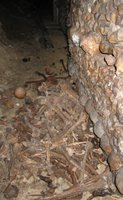The Ossuary

In preparation for my journey into the forbidden passages of the Parisian catacombs, I also visited the tunnels that have been opened to the public. I expected a well-lit, heavily-guarded, tourist-filled environment—an underground Disney Land. I was wrong.

Two tips for visiting the catacombs. First, don’t go alone. (I did.) It’s dark. It’s quiet. And you don’t know who’s down there. Second, wear boots or sneakers. (I didn’t.) There’s water dripping (sometimes pouring) from the ceiling in most of the tunnels. The floor in many sections is one large puddle. But despite all this, if you follow my advice, you should have a fabulous time.
The highlight of the catacombs is, of course, the ossuary where human bones line the tunnels. But in order to see it, you must be prepared to walk quite a distance through dimly lit, stone-lined passages with ceilings that hover only a few inches above the top of your head. In many respects, this is the creepiest part of the journey. As the tunnels twist and turn, you can only imagine what might lie in front of you.

When at last you reach the entrance to the ossuary, and read the warning above the door (“Stop, this is the empire of death”), you may feel as if you’re ready for anything. You aren’t. There’s nothing that will prepare you for the sight of human bones stacked in neat piles that can reach more than six feet in height. These are the remains six million Parisians who were buried in the city’s cemeteries before the 19th century.

In the late 1700s, when Paris’s cemeteries had been crammed (literally) beyond capacity, the dead developed a nasty habit of tumbling into the cellars of nearby buildings. The stench from the graveyards was reported to be overpowering, and those who lived in the surrounding areas often fell prey to the “bad air.” That’s when the authorities decided to empty the cemeteries and deliver the remains to the ancient Roman quarry that stretched beneath the city. The men who carted the bones were only allowed to work at night, and it was years before the last of the dead made the trip.

In the passages that are marked for sightseers, the bones of the dead are still artistically arranged, with skulls and femurs forming bizarre (often surprising) patterns. But if you pause to peer though the gates that block less traveled routes, you’ll see that many parts of the catacombs have not fared so well. Walls have crumbled, and the dead lay in chaotic heaps. A sharp eye will also find proof of the catacombs’ multiple layers. Look beyond the barriers, and you might find yourself staring down at a tunnel that weaves beneath your feet.
This was the first glimmer of what I might find in forbidden passages. But as fascinating as the ossuary was, I had no idea how little I’d seen.


2 Comments:
Cool, thanks for the post!
*teeheeheeheehee* I'm gonna go there when I go to Paris... If my mom lets me. I got my dad and my sister's agreement, but not my mom. TT-TT Noooo!
Post a Comment
<< Home